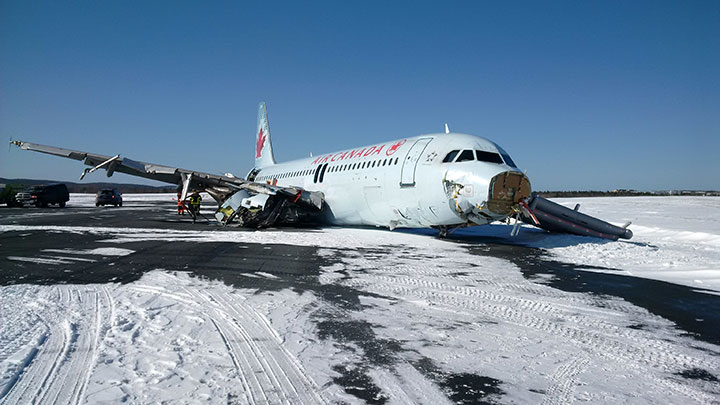
On March 29, 2015, what should have been a routine flight from Toronto to Halifax became a harrowing ordeal for the 133 passengers and five crew members on board, as the plane made a “hard landing” at the Stanfield International Airport (YHZ) in the midst of a severe winter storm. Despite significant damage to the aircraft, all passengers and crew survived the crash, though 25 people were treated for injuries and no doubt many of the passengers suffered psychological trauma from the event. Now four months after the incident, many questions remain about just what exactly happened on that evening.
The Transportation Safety Board (TSB) is investigating the incident, and on June 16, 2015, released a report on the preliminary findings of their investigation. This preliminary report does not yet identify what exactly caused the incident, nor does it assign blame to the crew, the plane, or any other specific combination of factors. It does, however, offer the first details about the final moments of that flight.
As it prepared to land, the aircraft (C-FTJP, an Airbus A320-200) was using a localizer approach to land on runway 5 at YHZ. A localizer approach only provides a pilot with lateral guidance to align their aircraft with the runway; this is less sophisticated than an Instrument Landing System (ILS), which provides precision lateral and vertical guidance to an approaching aircraft. Two of the runways at the Halifax airport have these more advanced systems, but runway 5 does not. As such, the pilots of AC624 were reliant on on-board systems for their vertical position as they prepared for landing. A number of people have called for upgrades to the landing systems at YHZ in the wake of this incident, including former pilots and other aviation experts, who have emphasized that ILS should be standard on all runways at an airport with the type of fog and snow conditions that YHZ receives.
The preliminary investigation of the aircraft suggests that at the time of landing, the airspeed was consistent with a normal landing approach, and the aircraft was configured appropriately for landing. No mechanical deficiencies were found in the aircraft’s systems, nor were any discrepancies noted in the maintenance records. Yet despite this, the plane approached the runway too low. The engines of the aircraft severed power lines, cutting power to much of the airport, before the landing gear and rear fuselage contacted the ground about 225 metres short of the runway threshold. The aircraft then continued, ironically enough, through the localizer antenna array, before pitching nose down into the ground 70 metres before the threshold. It then bounced and slid along the runway, coming to a stop 570 metres past the threshold.
Passengers evacuated the plane through the forward and mid-plane emergency exits, and then had to wait in the dark on a cold, snowy runway until emergency crews from the airport could arrive. According to some passengers, it was as much as 40 minutes before buses were brought to transport passengers to the terminal, though others have acknowledged that emergency crews provided immediate shelter and care to injured and particularly vulnerable passengers.
The weather at the time of the crash may well prove to be a factor. The TSB notes that the final weather update the crew received before landing was of a windspeed of 20 knots gusting to 26 knots from the north-northwest, with forward visibility of ½ statute mile in snow and blowing snow. Vertical visibility was 300 feet above the ground, and the temperature was at -6°C. Whether these conditions caused the pilots to misjudge their vertical approach is a question that the TSB will no doubt continue to examine.
The challenge for the TSB now remains to identify the exact cause of the incident. Their investigation will involve thorough recreations and simulations of the events, evaluation of pilot and flight attendant training and other safety practices, further evaluation of the aircraft and the airport landing systems, and additional interviews. The TSB release acknowledges that approach-and-landing incidents, are inherently dangerous, and continue to pose one of the greatest threats to aviation safety in Canada.
You can follow the most recent updates from the TSB’s investigation on their website HERE




